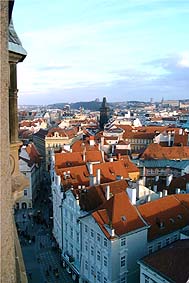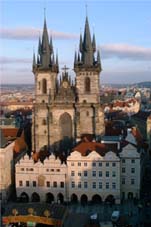|
Take the last look at the Wenceslas square from Mustek and then turn around. Na Mustku street and Melantrichova will take you directly to the Old Town Square. On your way you will pass by Havelsky trh (you can buy almost everything there). Also don't forget to check out two stores. One is called Botanicus and you will find a lot of neat natural things there, if you have no clue what to bring back with you, you will definitely get an idea there. Second store is a litle bit further and it is a store with Czech tradition art. Old Town Square and the adjoining streets have so much to offer so it is best to look through your guide to set your priorities and choose the places you want to visit. |
Before you go inside the Old Town Hall and climb its tower to overlook the historical city, stop to see the mechanical wonder of the late medieval engineering: The Astronomical Clock. Along with the main dial that shows Central European time, a wheel with signs of the zodiac turns inside the display revealing the position of the stars. The outer ring of the clock, marked with Arabic numerals, calculates the time from the precise moment of sunset. If you come on the hour, you will see the twelve apostles take turns peeking out from the two small doors above the clock. At the same time, figures symbolising Death, Vanity, Greed, and the Ottoman Invader placed around the clock move with the sound of the bells. The Grim Reaper tolls a bell and turns an hour glass signifying that the time has come for the remaining figures who shake their heads in denial.
On your way across the square you will pass by a group of 27 white crosses embedded in the pavement next to the Old Town Square. On this spot, 27 Czech Protestants were beheaded in 1621 by the Habsburgs; an event that ended the first phase of the Thirty Years' War and began the return of Bohemia to Catholicism. Unique paving- stone patterns are something to look out for when walking through the city: Designs and symbols on the pavement commemorate historical events and speak of legends. |
 |
|
|
The open area around the corner with benches and trees is the site of the former neo-Gothic north wing of the Old Town Hall that was burned down by Nazis a veek before the WWII ended. To understand the eclectic structure of the Old Town Hall, we have to trace the history of the Czech estates, especially of the Prague burghers who gradually gained power alongside Church, King and gentry. Prominent families from the town provided loans to their King. Hence, John of Luxembourg, needy of war funds, allowed the Old Town to found a hall for municipal purposes in 1338. A tax on wine paid for the purchase and development of the Wolflin House on the corner and the tower that was completed in 1364. The astronomical clock was added in 1410. As the town grew and prospered, Old Town Hall claimed more space and over the course of centuries all the buildings on the block were bought uo and reconstructed for the expanding municipal administration. First to be added was the Kriz House, Furrier House followed and the last acquisition was the House of the Minute, purchased in 1896. Reconstruction of its Baroque facade revealed a previously undocumented Renaissance sgraffito of spectacular quality. |
 |
Do not leave the Old Town Square without exploring its souther arcades. Many houses, Baroque and older, have house signs and this is something to keep a lookout for when sightseeing in the Old Town and Mala Strana. In the past, the signs served to identify houses. For exemple, House No. 25, across the square from the Astronomical Clock, is the House of the Blue Star. Further down the arcades, No.20 is the House of the Golden Unicorn, No.18 is the House of the Stone Table.
Houses on the north side across the square were built at the turn of the century, replacing he squalor on the south boundary of the formaer Jewish ghetto. The only exception of to the rule is a former convent of the Pauline order; it is the three story Baroque building. The baroque church is St. Nicholas, designed by Killian Ignac Dientzenhofer, an architect from a family of renowned Bavarian builders who settled in Prague. Dientzenhofer also designed the Church if St. Nicholas in Mala Strana. The Old Town St. Nicholas changed hands several times and now is owned by th Czechoslovak Hussite Church.
In the middle of the square is a monument dedicated to Jan Hus by the sculptor Ladislav Saloun. The religious dissenter Jan Hus (John Huss) was burned for his views by the Catholic church in 1415. Across the monument is the late Baroque Goltz-Kinsky Palace. A significant moment in modern Czech history took place at the Palace when Gottwald announced the communist coup from the balcony of the Palace to a crowded square in February 1948. In the 1800's while staying at the palace was convinced by the Baroness Bertha von Suttner to found the Nobel Peace Prize. Next to the Palace is the House of the Stone Bell, a building with the best preserved Gothic facade in Prague. The Stone Bell now houses an art gallery.
On the right side you can't miss the Church if the Virgin Mary of Tyn (Tyn). The first church stood as early as 1135, but the foundations of the present day church were laid two hundred years later. The great fire of 1689 led to a major reconstruction of the church and its Baroque interior is one of the finest Prague has to offer. |
 |
|
|
I understand that absinthe makes the tart grow fonder. —Ernest Dowson
©2000-2010 Prague2001.com - Enjoy the magic of Prague, Czech Republic.
|
|
|
